#216: Ductifera pululahuana
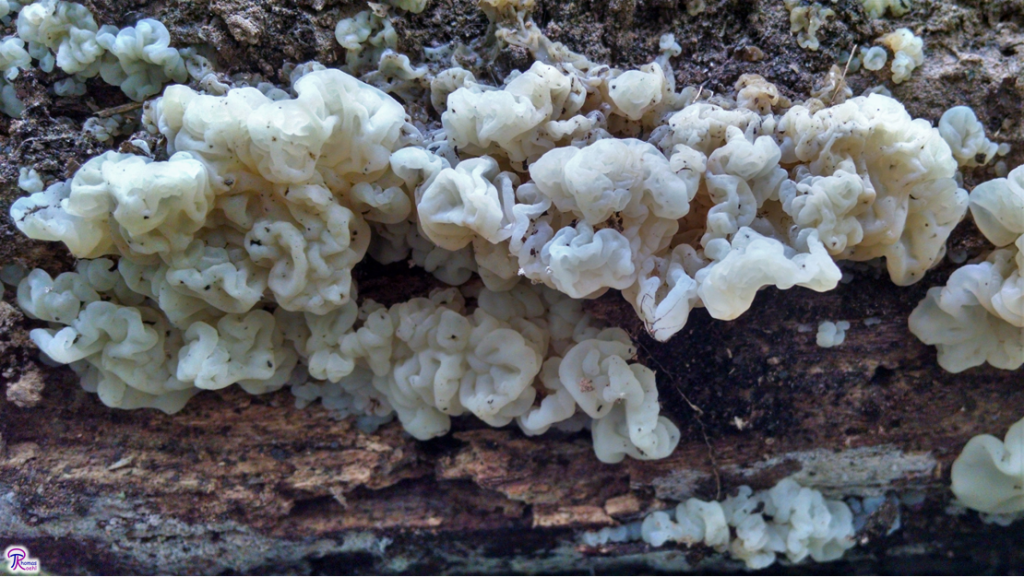
Ductifera pululahuana is a strikingly white jelly fungus. It is distinctive thanks to its white color, tight curving lobes, and growth on old wood.
In my area, Ductifera pululahuana is the second most common jelly fungus (after the Wood Ear, FFF#134) that appears in late spring or early summer. It is a strikingly white mushroom that grows in clusters of densely-packed irregular lobes. This shape reminds me of something in between popcorn and fluffy mashed potatoes. Despite this airy appearance, D. pululahuana is rather dense and thick, especially compared to other jelly fungi. I find the ten-syllable scientific name difficult to remember, especially after not using it at all over the winter. When I forget the name, I fall back on the out-of-date name Exidia alba. It’s much easier to remember and refers to the same mushroom, even if it’s incorrect today. The mushroom also goes by the common names “Pale Jelly Roll” and “White Jelly Fungus,” but I’ve never heard those used.1
Description
Ductifera pululahuana grows in dense clusters of fused lobes that can reach up to 15cm across. Individual lobes are usually fan-shaped and grow no more than 3cm in diameter, but they routinely fuse with other lobes so separating them is difficult. At first, the lobes are bright white but they soon discolor yellowish and then darken to brownish or pinkish or purplish in age.1–3 D. pululahuana seems to build upon itself, so newer lobes grow on top of older ones. As a result, the interior of the mushroom is older and darker than the exterior.
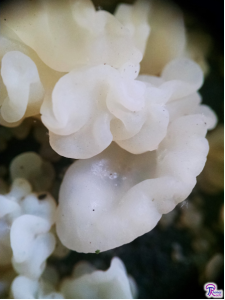
The lobes of D. pululahuana are rounded, tightly clustered, and fused together. Its texture is thicker and more brittle than most jelly fungi.
The mushroom has a texture that is unusually dense and brittle for jelly fungi. It still feels wet and gelatinous, but it doesn’t squish or bend quite as much as other jelly fungi do. Collecting and transporting D. pululahuana is also different; the mushroom is very easy to slice through but will fall apart if you’re not gentle. I’ve never found a dried-up specimen of this fungus, so it seems to decompose fairly quickly after it fruits. This is another factor that sets it apart from other jelly fungi, which tend to dry out and rehydrate multiple times over a season or even a full year. Given how dense the mushroom is, I suspect that it doesn’t get much smaller as it dries out.
Ecology
D. pululahuana appears on old hardwood logs, usually ones without any bark left. The species is most likely saprobic, although jelly fungi tend to have complex life cycles so mycologists aren’t yet completely sure what its role is. The fungus is a relatively late addition to the hardwood decomposer community, which is rare for a jelly fungus; most jelly fungi appear long before the bark falls off a log. 1–3 D. pululahuana grows from the midwestern and eastern United States south to at least Ecuador.2 Entries on Mushroom Observer and iNaturalist indicate that within the United States the species is most common in a two-state radius from Ohio and Indiana.4,5 The mushroom appears from late spring through fall in temperate areas, but likely can fruit year-round in tropical climates.1–3 In my area (mid-Atlantic), it is most common from around Labor Day to July 4th.
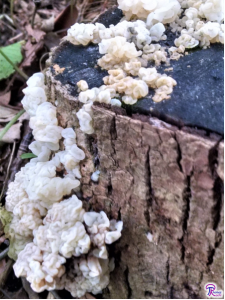
D. pululahuana usually grows on old wood without any bark. However, I’ve seen it on cut trees recently (ones that were cut a while ago but still have bark). Perhaps it just needs exposed wood to start growing.
Similar Species
The species most similar to D. pululahuana is Tremella fuciformis (FFF#023). That fungus also produces white gelatinous mushrooms but tends to be smaller (it can still get up to 7cm across, so it’s not small) and has pointier and more distinct lobes.6 Other species of Tremella, such as T. mesenterica (Witch’s Butter, FFF#059) and T. foliacea, have convoluted and fused lobes but these mushrooms are usually more highly colored (yellow or brown, respectively). You can find white forms of Witch’s Butter but those have a much looser structure and thinner flesh than D. pululahuana.
Other continents have different white jelly fungi but D. pululahuana is known only from North America.2 Check local field guides to identify similar mushrooms elsewhere.
Edibility
Officially, D. pululahuana is listed as “unknown” or “inedible.”1,3 This isn’t very surprising; once you pick it up, the mushroom is rather unappetizing. Although the mushroom looks nice on the surface, it has a brittle texture, discolors quickly, and is often mealy and slimy in the middle. I found one report of someone eating the mushroom and the author did not report any side effects. > They also weren’t impressed with the culinary qualities of D. pululahuana.7 All things considered, even if the mushroom isn’t poisonous, it’s not good enough to consider edible.
Taxonomy and Etymology
The mushroom’s species name – pululahuana – name might sound Hawaiian, but it’s actually derived from the name of an Ecuadoran town. Mycologist Patouillard, who originally described the species, first collected it in Pululahua, Ecuador and named the species after that locale.2
D. pululahuana belongs to the order Auriculariales and family Exidiaceae,8 so its closest relatives are other wood-inhabiting jelly fungi such as the Wood Ear, Auricularia auricula, and the much smaller and darker Exidia glandulosa (for more on jelly fungi, see FFF#048). Ductifera is a small genus that includes fewer than 20 named species.9 D. pululahuana is the only species of Ductifera that I’m familiar with, so you don’t encounter the genus very often.
| Kingdom | Fungi |
| Subkingdom | Dikarya |
| Division (Phylum) | Basidiomycota |
| Subdivision (Subphylum) | Agaricomycotina |
| Class | Agaricomycetes |
| Subclass | Auriculariomycetidae |
| Order | Auriculariales |
| Family | Exidiaceae |
| Genus | Ductifera |
| Species | Ductifera pululahuana (Pat.) Wells8 |
Citations
- Emberger, G. Ductifera pululahuana. Fungi Growing on Wood (2008). Available at: https://www.messiah.edu/Oakes/fungi_on_wood/jelly%20fungi/species%20pages/Ductifera%20pululahuana.htm. (Accessed: 29th June 2018)
- Kuo, M. Ductifera pululahuana. MushroomExpert.Com (2004). Available at: http://www.mushroomexpert.com/ductifera_pululahuana.html. (Accessed: 29th June 2018)
- Labbé, R. Ductifera pululahuana / Exidie blanche. Les champignons du Québec (2016). Available at: https://www.mycoquebec.org. (Accessed: 29th June 2018)
- Occurrence Map for Ductifera pululahuana (Pat.) Wells. Mushroom Observer Available at: https://mushroomobserver.org/name/map/22144. (Accessed: 29th June 2018)
- White Jelly Fungus (Ductifera pululahuana). iNaturalist.org Available at: https://www.inaturalist.org/taxa/320321-Ductifera-pululahuana. (Accessed: 29th June 2018)
- Kuo, M. Tremella fuciformis. MushroomExpert.Com (2008). Available at: http://www.mushroomexpert.com/tremella_fuciformis.html. (Accessed: 29th June 2018)
- DeTwizzle. Exidia alba (Ductifera pululahuana) meal. Shroomery: Magic Mushrooms Demystified Available at: https://www.shroomery.org/forums/showflat.php/Number/20102182. (Accessed: 29th June 2018)
- Ductifera pululahuana. Mycobank Available at: http://www.mycobank.org/Biolomics.aspx?Table=Mycobank&Rec=11856&Fields=All. (Accessed: 29th June 2018)
- Ductifera. Mycobank Available at: http://www.mycobank.org/BioloMICS.aspx?TableKey=14682616000000067&Rec=58001&Fields=All. (Accessed: 29th June 2018)

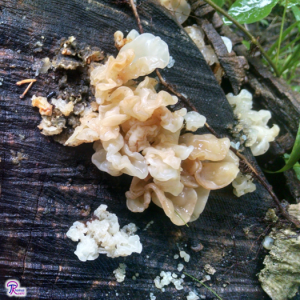
![#146: Gliophorus psittacinus, the Parrot Mushroom [Archived]](https://www.fungusfactfriday.com/wp-content/themes/hueman/assets/front/img/thumb-medium-empty.png)
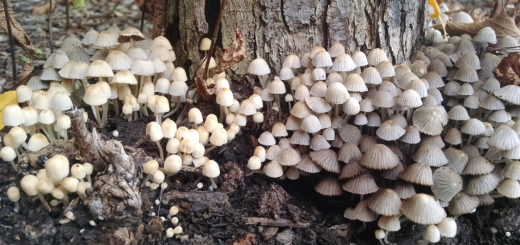





![#011: Characteristics of Kingdom Fungi [Archived]](https://www.fungusfactfriday.com/wp-content/themes/hueman/assets/front/img/thumb-small-empty.png)
